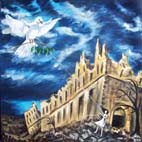This year the New Zealand Embassy hosted the Anzac Day service at the Rome War Cemetery. The day was damp and overcast, fitting the mood in the small but interesting cemetery. There are not many New Zealand soldiers buried here, but those who are there had many visitors and were remembered along with those who are still risking their lives fighting in conflicts today.



Masters of Ceremonies were Wing Commander Ian MacPherson, NZDF and Chief Petty Officer James Dew, ADF. Prayers were led by Father Paul Martin SM and Canon David Richardson and the reading was given by His Excellency David Ritchie, Australian Ambassador. His Excellency Dr Trevor Matheson, New Zealand Ambassador-Designate (pictured below), gave the address.

The service was traditional, and wreaths were laid by representatives of 19 countries and organisations. The singing, unaccompanied as earlier rain prevented the use of a sound system, was both prayerful and patriotic.
From the opening prayer in Rome on Anzac day 2011 comes this hope for mankind:
"We ask that the liberty, truth and justice which [the fallen soldiers] sought to preserve may be seen and known in all the nations upon this earth".
One phrase in the closing prayer (Canon David Richardson) struck a particular chord with me, praying for "peace among nations, peace in our homes, and peace in our hearts".
The Prayers of Intercession (Father Paul Martin SM) are copied here:
Let us pray for leaders of nations, and for all who are working to promote understanding between peoples, that their efforts may bring about justice, freedom and lasting peace.
Let us pray for those who suffer today as a result of war, terrorism and all forms of violence, that through their suffering we may learn to resolve conflicts without bloodshed.
Let us pray for the men and women of all our countries who have died in war, especially for those who are buried in this place, that their self-sacrificing courage may inspire us to face the difficulties in our time with integrity and goodwill.
Let us remember especially those who this day commemorates, and the contribution they have made to the growth of our nations. May we never forget the ideals for which they have died.
Let us spend a moment in silent prayer asking God for the gift of peace; for ourselves and our families, our communities, and our world.
As I looked at the young piper standing alone behind the cenotaph I wondered how long it would be before he too had to decide where he stood as a peace maker.

Music, like art, is an effective weapon of choice. Music unites and inspires us to seek greater things. It can also be used to unite to draw strength to attack a perceived enemy. I recall a poster from many years ago: "There are no strangers in this world, only friends I have yet to meet". Let music and art always be used to educate, to forge friendships, to promote harmony, to bring about a lasting peace.











